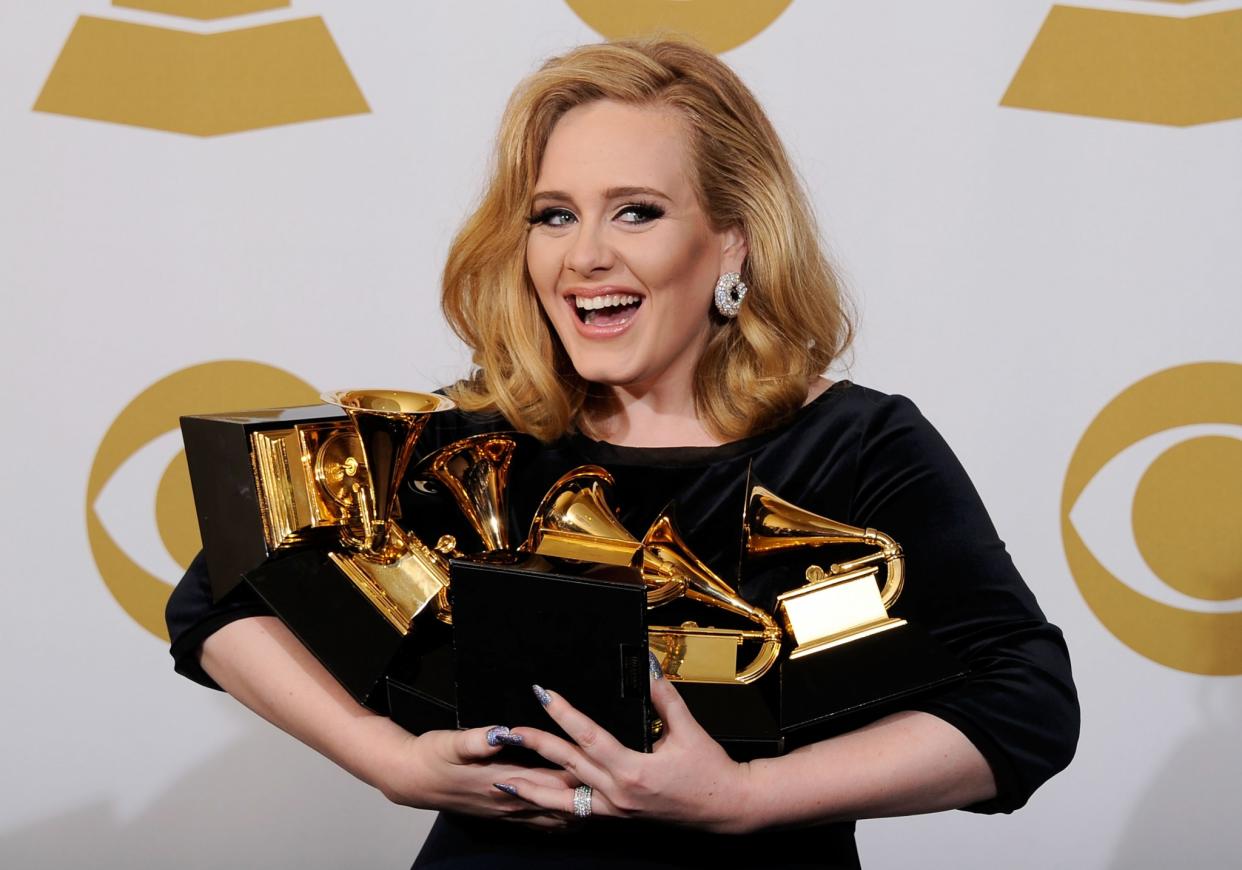Why It's So Hard to Follow a Grammy Album of the Year Winner

When the 59th annual Grammy nominations are announced on Tuesday, Dec. 6, Adele’s 25 is virtually certain to be in the running for Album of the Year. You might say, “Well, she won with her last album, 21. It stands to reason she’s going to be nominated again!” That seems logical… but it doesn’t usually work that way. 25 would be the first follow-up to an Album of the Year winner to be nominated in that category since Bob Dylan’s Love and Theft, his 2001 follow-up to the 1997 champ, Time Out Of Mind.
Among the follow-ups to Album of the Year winners since 2001 that have been passed over for Album of the Year nominations: Santana’s Shaman (their 2002 follow-up to Supernatural), Norah Jones’s Feels Like Home (her 2004 follow-up to Come Away With Me), U2’s No Line on the Horizon (their 2009 follow-up to How to Dismantle an Atomic Bomb), Taylor Swift’s Speak Now (her 2010 follow-up to Fearless), Arcade Fire’s Reflektor (their 2013 follow-up to The Suburbs), and Mumford & Sons’ Wilder Mind (their 2015 follow-up to Babel).
Why is it so hard to follow an Album of the Year winner with another album deemed worthy of a nomination? Once you’ve won Album of the Year, greatness is expected. Anything less is viewed as a disappointment. Flaws are magnified. There is little opportunity for surprise, the kind that makes people say, “Hey, this is really good.”
Also, since 1995, the final nominations in this category have been determined by a committee of Grammy insiders. Once an artist has won the top award, some committee members may think, consciously or subconsciously, that it would be better to give that nomination slot to an artist who hasn’t yet won.
Also, many Album of the Year winners are career-capping blockbusters, which are always hard to follow — Grammy or no Grammy. A classic example is Carole King’s Music (her 1971 follow-up to Tapestry). There are many other examples, including Blood, Sweat & Tears 3 (their 1970 follow-up to Blood, Sweat & Tears), Fleetwood Mac’s Tusk (their 1979 follow-up to Rumours), Lionel Richie’s Dancing on the Ceiling (his 1986 follow-up to Can’t Slow Down), George Michael’s Listen Without Prejudice (his 1990 follow-up to Faith), and Celine Dion’s Let’s Talk About Love (her 1997 follow-up to Falling Into You). Some of these follow-ups sold very well, some fell short, but all were perhaps inevitably overshadowed by their megahit predecessors.
This can be especially hard for new artists. The Grammy spotlight can make a successful debut even harder to follow. Examples include Christopher Cross’s Another Page (his 1983 follow-up to his hit-studded debut album, Christopher Cross) Alanis Morissette’s Supposed Former Infatuation Junkie (her 1998 follow-up to her U.S. debut, Jagged Little Pill), and Norah Jones’s aforementioned Feels Like Home (her 2004 follow-up to her blockbuster debut album). None of the follow-ups received Album of the Year noms, though Feels Like Home was nominated for Best Pop Vocal Album.
Two artists who won Album of the Year with mega-selling soundtracks failed to receive a nom in that category for their following studio albums. The Bee Gees’ Spirits Having Flown, their first album after Saturday Night Fever, was passed over, as was Whitney Houston’s My Love Is Your Love, her first studio album after The Bodyguard.
And George Harrison’s Living in the Material World, his first album after leading the all-star charity event The Concert for Bangla Desh, failed to receive an Album of the Year nomination.
The difficulty in following Album of the Year winners may be one reason that several artists who won the top prize with their last studio albums are taking their sweet time with their follow-ups. We’re still waiting for studio follow-ups by 2006 winners the Dixie Chicks, 2003 winners Outkast, and Lauryn Hill, the 1998 winner. (Hill released a live album in 2002; Outkast released a soundtrack album in 2006.)
Given how hard it is, it’s worth noting the follow-ups to Album of the Year winners that did manage to be nominated in that category. The short roster includes (in addition to the aforementioned Dylan and Wonder albums) the Beatles’ Magical Mystery Tour (their 1967 follow-up to Sgt. Pepper’s Lonely Hearts Club Band), Billy Joel’s Glass Houses (his 1980 follow-up to 52nd Street), Michael Jackson’s Bad (his 1987 follow-up to Thriller), Phil Collins’s …But Seriously (his 1989 follow-up to No Jacket Required), Paul Simon’s The Rhythm of the Saints (his 1990 follow-up to Graceland), Bonnie Raitt’s Luck of the Draw (her 1991 follow-up to Nick of Time), and Eric Clapton’s From the Cradle (his 1994 follow-up to Unplugged).
If Adele’s 25 wins for Album of the Year when the Grammys are presented in February of next year, it will mark the first time that an artist has won in this category with back-to-back studio albums since the mid-’70s, when Stevie Wonder won with three consecutive album releases — Inner Visions, Fulfillingness’ First Finale, and Songs in the Key of Life. Before that, the only artist to win Album of the Year with back-to-back studio albums was Frank Sinatra, who won in the mid-’60s with September of My Years and A Man and His Music (which consisted of newly recorded versions of his classic hits).

